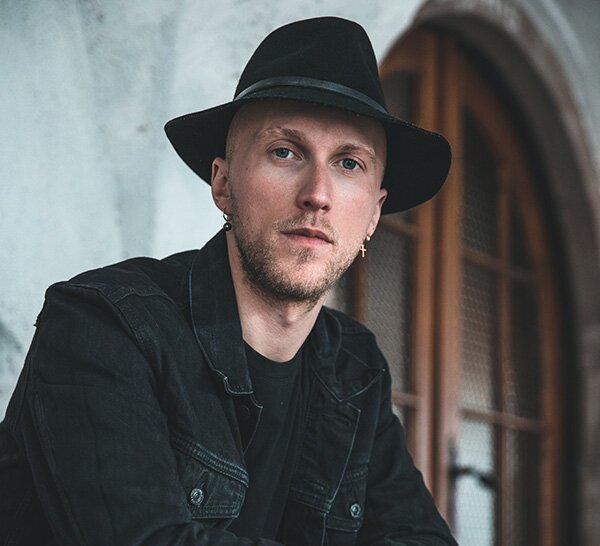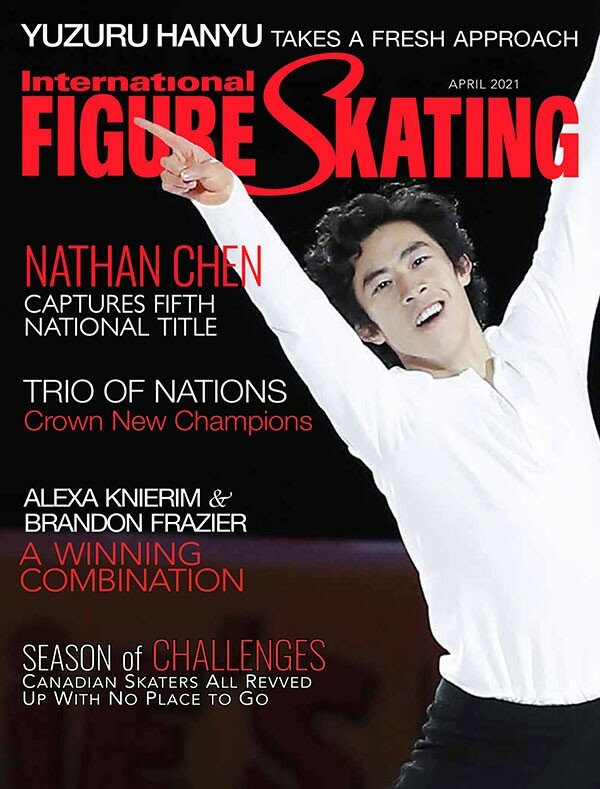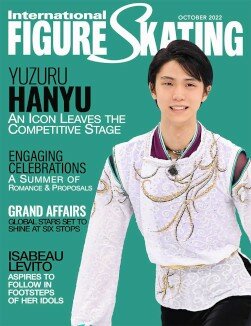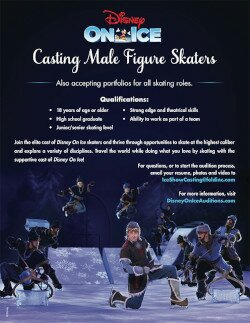

French choreographer Benoît Richaud, a former competitive ice dancer, has worked with some of the world’s best skaters the past few years. Breaking into the top echelons of his craft was a challenge, but he won over a legion of fans with his innovative and original programs.
What is your background and how did you get into figure skating?
I come from Avignon in the south of France, where skating is not popular. I went to the rink to see my cousin who took skating lessons and I wanted to try it right away. I loved it. I was able to skate naturally and my cousin was not happy because she had been doing it for some months and I was able to glide from the first class.
I did singles skating from 6 to 9 years old. I had all the double jumps and I had started working on triples. But, at school, I heard lots of comments like ‘skating is a sport for girls.’ So I stopped skating and started playing rugby. But later, I realized I missed skating and I started again when I was 11. It was tragic because I couldn’t jump anymore. My body had changed and I had a lot of trouble regaining my jumps.
Then I saw Marina Anissina and Gwendal Peizerat on television winning the 2002 Olympic title and that was a revelation for me. I told my mother I wanted to do this. She talked to my coaches and I told them I wanted to train with the same coaches as Marina and Gwendal. My coaches said, ‘you are crazy. They will never take you.’ My mother called Muriel Zazoui and we got a reply to come for a test.
So, in May 2002 my mother and I went to Lyon and I skated for one hour with Muriel and three hours with Romain Haguenauer. At the end of the day, they told my mother they were not taking children, but they would make an exception for me. I was 13 years old at the time. I did solo dance until they found a partner for me.
What did you achieve in your competitive career?
After finishing first or second at novice nationals, I moved up to juniors and was the French junior ice dance champion (with partner Élodie Brouiller). I remember in our first Junior Grand Prix season (2005-2006) we finished fifth in Estonia and fourth in Japan. That was quite exceptional. The following season, we finished seventh at the Junior Grand Prix Final and also at 2007 Junior Worlds.
However, it was very difficult for anyone to skate with me. I did not have the team spirit. That was the reason why my first partner quit. I found another partner, (Canadian) Terra Findlay, and it went quite well, but after moving up to the senior level in 2009, I stopped and left ice dance the same sudden way I had entered it. I went to work in a bar in Avignon as a server when I was 21 years old.
Do you regret that you ended your career so early?
I do not have any regrets because looking back now I understand that I did not enjoy competing. I liked to train and create new programs; I liked everything around it but not the competition. I was not made for that.
When and why did you return to the sport?
One day I received an email from Holiday on Ice with an offer to compete on a reality television show, “Dancing on Ice,” in the Netherlands. I didn’t like it at all, but I found the concept of a television production very interesting. The most important thing was that I realized I missed skating. The choreographer of the show, Douglas Webster of Ice Dance International, told me that I needed to return to skating because he thought I had something special.
After the show I started coaching ice dance in Basel, Switzerland. I worked with senior skaters for a year and it was a great experience. I had two teams that were first and second at the national championships. I went to 2015 Europeans with Katarina Paice and Yuri Eremenko. During the time I was in Basel, I started working on skating skills and choreography with young Swiss skaters.
I contacted Ingrida Snieškienė, the first coach of Deniss Vasiljevs, and said I would like to try doing choreography for Deniss. She agreed. It was my first real experience to work with a singles skater and, when he debuted his “Adagio for TRON” by Daft Punk program in 2014, I saw that people liked my choreography. So I stopped working as an ice dance coach and became a choreographer.
I started working with skaters on the French national team and some from Switzerland. After the 2015 World Championships I went to Champéry, Switzerland, where I met Alexei Mishin, who was there to get a program from Stéphane Lambiel for Liza Tuktamysheva.
One day he said he wanted me to do choreography for her. I was a little embarrassed because they had come to get choreography from Stéphane — and then I was asked to do it for her. Alexei liked my work and invited me to his summer camps in Turkey and Estonia that year. I worked all summer with his team and it went really well. At 2016 Junior Worlds I was approached by the Japanese federation and later contacted by Russian ice dancers Alla Loboda and Pavel Drozd and Ivett Tóth from Hungary.
From what sources do you draw your inspiration for the programs?
Since I was very young, my eye was attracted to details and I think this is reflected in my choreography. I spent a lot of time watching performances on YouTube or on dance forums, and a lot of time educating myself, listening to music, watching the great modern dance choreographers and neo classics and that had a big impact on me. I was attracted to modern art, new art. That doesn’t mean that I do not appreciate the classics, but in dance I am a bit less attracted by the classics.
I also spent a lot of time studying the great composers. There were some whose music I had already used, but I realized that I did not know enough about their lives. I started with Sergei Rachmaninov — he is my favorite — and the Estonian composer Arvo Pärt. I also love Mozart, Beethoven and all the great composers.
Who did you choreograph programs for this season?
I worked with Rika Kihira, Yuna Shiraiwa, Kaori Sakamoto, Shun Sato, Daniel Grassl, Ekaterina Kurakova, Gabriele Frangipani, Adam Siao Him Fa, Luc Maierhofer, Eva-Lotta Kiibus, Bradie Tennell and the U.S. pairs team of Jessica Calalang and Brian Johnson.
With Satoko Miyahara, I reworked the short program I did for her last year. She decided to use it for her gala performances this season. These are the senior level skaters, and there are some more in juniors.
When you work with so many skaters, how do you avoid your programs becoming duplicates of each other?
I have six girls in the top 12 and none of their programs are similar to the other. I do not think about this when creating the programs, as I am very invested in the elevation of the person I do the choreography for. Sometimes it is very hard for skaters because I do not tolerate people that do not work hard and I do not accept it if they do not give it their all.
It is easy to avoid programs being similar with all the music choices that we have, and it is complicated to “clone” skaters. I know there are some people — I won’t name them — that do this. You see the same movements, the same gestures. It is very similar because it is always classical music. But, for me, it is not possible to do that.
Whether I take someone that is top five or 20th at the World Championships, when I work with them something more interesting is happening than in years past. Yes, from time to time there are some things that are a bit similar, but I do the programs so much based on the personality of the skater that I am not afraid to have a moment where people who are watching might say: ‘This is the same music style, same costume, same choreography.’ But I do not do a jazz short program for one skater and then give jazz to another skater.
You previously worked with Daisuke Takahashi who is a very artistic skater. Can you talk about that experience?
Daisuke is fantastic. It was an honor that he contacted me. He told me he had seen my work over the past few years and thought my choreography was special.
When he came to France to get a new program, we did not have any music ready so everything happened on site. We spent a lot of time talking about life over a glass of wine and I got to know his personality. Being a choreographer is also a bit like being a psychologist.
He is a very high-level skater with a personality. What was interesting was that he asked me to develop another facet of his personality; he really wanted me to do something different. He felt that over the years his programs had become similar. I suggested different pieces of music — there was a piece that I really liked by Rachmaninov, rearranged in a more modern way. I had Daisuke listen to it and he loved it immediately.
I suggested a very modern choreography to him that was a mix of the darkness and the elegance of Daisuke. He has a very dark but very beautiful elegance and that worked very well with Rachmaninov. We tried the music on ice — there was a lot of improvisation; I suggested moves and he did them. Very quickly we knew that it would work and we did the program within a week.
We did that choreography during Alexei Mishin’s camp in Courchevel and he had his skaters sit down after their practices to watch Daisuke because he trained all day. Mishin told his students, ‘take an example from this great champion and look how he is training, how he is working, how he moves and dances.’
This season you worked with Rika Kihira. Can you tell us how that collaboration worked out?
It was very interesting. I was surprised when she contacted me during the summer because I thought her programs had already been choreographed. She and her mother had seen my work with other Japanese skaters and she said she had wanted to work with me for some years. I do not know why it did not happen before.
She asked me if I would do a short program. I told her to come to Italy. It was perfect timing and it went really well. We chose the music together, but I didn’t like the choice (“The Fire Within” by Jennifer Thomas) too much in the beginning, so I asked my music guru Cédric Tour to re-orchestrate it. He arranged something very interesting. I had Rika listen to it and she loved it.
The choreography was done quickly. It was very professional — there was no hesitation, no bad moments, no misunderstandings. Rika does not communicate too much in English, so we worked by feeling and sharing the movements, skating them together on the ice.
I like to share the movements with the skaters who do not speak English very well. Skating becomes the common language and you do not have to communicate too much with words. Some people say my choreography is challenging, but Rika was very open to trying new ideas. When we worked on the one-handed cartwheel, she wanted to do it. I had tried it with other people that did not want to do it.
When we finished the program everyone was surprised, including Rika, to see that in just a few days she had changed her style. I do not want to say that it wasn’t good before and that it is good now, but it was like an update.
How hard was it to break into the upper echelons in the world of choreography?
Perhaps one of the things that gave my career credibility was the fact that Daisuke trusted me to do the program for his comeback. He could have worked with any choreographer he had worked with before, but he wanted to work with me. I think that was a good message for the skating world.
I found my space in a world where all the choreographers have been the same for 25 years. Everyone told me it would be impossible and that I would never be at a high level because it is only Lori Nichol, David Wilson, Shae-Lynn Bourne and Jeffrey Buttle. In fact, I realized that by working hard, it happened step by step.
Some skaters are more artistic than others. How do you deal with the different levels?
People like to compare, but the important thing is to find the personality of the skater. Each skater has a force. There are always skaters that are more artistic than others and I do not always have the most artistic skaters. I had Daisuke and I worked with Denis Ten, but people first saw my work with skaters that were not very artistic, but they started to like the choreography of those skaters.
I see negative comments from people who say they do not like my work. I sometimes hear things like, ‘Kaori Sakamoto does not have beautiful arm movements,’ but Kaori is Kaori — she is not Michelle Kwan.
To do choreography for someone like Patrick Chan or Carolina Kostner is very easy. This is not a criticism as I had this experience as well when I did a program for Denis Ten. It was fantastic to work with him because he was also a friend. When we were on the Junior Grand Prix circuit, we were together all the time. With artists you can do incredible things.
But it is also very interesting to work with someone who basically cannot dance and make them look fantastic on the ice. People asked in the beginning what I was going to do with Bradie Tennell. When I started working with her, she was like eighth at nationals, and the next year she was the U.S. champion. As you find the ingredient that makes each skater work, each season it gets better. I remember people saying that she cannot perform, only jump, but every season Bradie’s components scores get better. At 2021 nationals she had much higher component scores than everybody else.
How challenging is it to combine creative choreography with the difficult technical content?
I do not think it is difficult at all because I accept it. I know the rules very well and I do not think it is contradictory. We cannot forget that figure skating is a sport and if people come to see a choreographer, it is to make a program with technical elements. I look at it more as a game that you need to win. The choreography needs to work and you need to find the right combination, the right ingredients, to make it work.
Daniel Grassl has like five quads in his programs. He is interesting. I started working with him when he was 15 and still in juniors. The coach decides the technical elements and it is the role of the choreographer to know where to place them. I need to know where to place the elements in the program to make it comfortable for the skater. I like the challenge of combining the rules with what I like in a program.
The difficulty can affect the creativity, but it does not disturb me — it motivates me to be even more creative. If I do an opening that I love but realize it is too long, I stop and do something different. I always manage to find something better in the end. That is the creativity in skating; it is totally different from dance.
You were an ice dancer but you do not do choreograph programs for that discipline.
I do not do ice dance for several reasons. In figure skating, the elements are the jumps, the spins and that’s it. In ice dance, the technical elements are 80 percent of the program. I realized that when you do ice dance choreography it is changed so much during the season by the coaches because they need to get the technical scores. In fact, if you want to be an ice dance choreographer you need to be a coach — and if you look at it, most of the ice dance coaches do the choreography for their skaters. So I have not explored that. I would like to do it, but I have not searched for opportunities.
I am very interested in working with pairs teams. There is something I like a lot about pairs, but I have not had many teams, which is a shame. Aljona Savchenko was very disappointed that we only started to work together at the end of her career. She and Bruno (Massot) loved working with me. She wondered why we didn’t work together earlier. I could have done a lot of interesting programs for them.
I have worked in the U.S. and I was asked to go to Russia but because of the coronavirus, that did not happen. I have worked with the Chinese pairs teams and I liked it. I like working with singles and pairs because you can do really interesting things artistically.
What, if any, is the difference between choreographing programs for ladies and men?
Good question. In my work I do not see a big difference between women and men because, for me, there are no ‘men and women.’ It is 2021 and I see people as people. I am interested in the person, the soul of the person. So I do not see a difference in that regard.
But, I work a lot more with ladies than with men and I would say the ladies are much stronger than the men. They accept the work and the corrections much easier than the men do. I have realized, strangely, that the guys are more emotional than the ladies.
They always have a problem. ‘I am hurting here and there; I cannot skate more than one or two hours…’ Never with the ladies! They never complain. I really appreciate their strength of character. I like to work hard and I do a lot of repetitions and that is a bit more complicated for many of the guys. Not all, though.
Over the years I also realized I have this vision of women being strong. Women are very important to me and I have done very few programs where I presented the woman as fragile. I finally understood that this is because of my perception of women. I am not an old school man at all; I have so much respect for them. God has given women something much stronger than men and I show this in my choreography. I like that the women are strong and powerful, even in the music choice.
Throughout the pandemic, you had to do a lot of choreography online. How did that work out for you?
It was very interesting. First of all, I like it when it is difficult. I like it when I am told it is ‘not possible’ or when I am told not to do it, or that I would never manage. I want to do it even more then. When the coronavirus appeared I understood very quickly that I would need to do work online and I accepted it.
In the beginning it was difficult because I had never worked that way. I am really into developing the relationship, the feeling, and being with the skater and moving with them on the ice, but I have learned to share my choreography through words, by explaining much more.
It required a lot more talking and I had to do it in my living room, which became my ice rink. I created the majority of my programs like that and I have to say it worked very well. It took more time, but on the other hand, as we say in France, ‘Do you see the glass as half full or half empty?’
I have never had more contact with some of my skaters as much as I do now. Before, I worked with them for just four weeks a year, but now I work with them every week. Thanks to the Internet, we can work together every day. There are good sides to this experience and I think that something will develop from it in the future, and that it has already started.
Sure, I will travel again and choreography will be done in real time. However, I think the virtual work will be interesting in the future. Maybe I’ll go to China, the U.S. or Japan to do choreography or the skaters will come to me — and then afterwards, we can continue to work during the season online. We did not utilize that tool in the sport before.
If I had suggested to my skaters to work online before COVID- 19, they would have said, ‘No, that doesn’t work,’ ‘that is not good,’ or ‘I do not understand.’ But now, everyone is saying, ‘Ah yes, it is working’ because there is no choice.
It is also nice to be able to pick up my kids every day from school. I work with the skaters and then my son comes to see me. This was not possible before the pandemic.
What is your opinion with respect to raising the age limit in skating?
I am totally, 250 percent for raising the age limit for two reasons. It has nothing to do with Russia because I respect Russia very much. I would like to be Russian in many ways because what they are doing for figure skating is fantastic. It is not about being jealous. The Russians are winning because they have a system.
But I believe the age limit is a question that needs to be asked. The one thing that is very disappointing is when I see champions disappearing quickly like Evgenia Medvedeva and Alina Zagitova who are very interesting. They have a lot of personality and it is a shame that all these skaters disappear. There is no problem with an age limit for the men because as the men develop with maturity their body is changing, but with the ladies, we see clearly that there is a problem.
Also, the ladies are stronger technically in juniors than in seniors. You can do something when you are 13, 14 or 15 years old but cannot manage it at 17 or 18. Only some can manage it later — there is the example of Elizaveta Tuktamysheva. That’s it. She is the only one and she does not have the consistency she had when she was 14 years old.
Now we are looking at two competitions: You have the young ones that are very good technically, but they won’t maintain that after one or two years. This is a shame. I was at the Grand Prix Final with Bradie last season and she noted that she was 21 years old and the others were all between 15 and 17.
The problem is that they are mostly Russian — you rarely see the Americans, Japanese or others on a podium. I do not think raising the age limit will be a negative for Russia. The Russians can still win if they skate clean, but they won’t skate clean all the time in all competitions. There are probably competitions where they would make errors and then it could be Rika or Bradie, or another skater from another country that would win.
If you asked all the female skaters who have stopped if they would like to continue, I think they would all say yes. We could see very nice senior-level competitions with Elena Radionova, Anna Pogorilaya, Zagitova, Tuktamysheva and Medvedeva and have in juniors Alexandra Trusova, Anna Shcherbakova and Alena Kostornaia. They could move up to seniors at 17, and then we would see.
I find the current system works very well for the men; there is a group that stays for about 10 years, who battle against each other. You watch them develop, know their personalities and you can get attached to them emotionally. But you do not have that so much with the ladies. I would also like to see other countries on the podium at the European Championships, but as long as we have this age thing it won’t happen. For the men it happens, but not for the ladies. A lot of people would like to see a change.
Can you talk about your projects, Peak Ice Camps and the Carte Blanche Show?
Peak Ice Camps are training camps. I plan to organize skating skills camps in Europe, Japan and the U.S. I do these camps in France now but the idea is to develop them internationally to give everyone a chance to participate.
The goal is really to re-educate through these camps. No matter if someone is an Olympic champion or will never go to Worlds or an Olympic Games, I teach the same things the same way. It is the same when I do choreography for high level or lower level skaters.
There is also a Peak Ice Camp where I invite high-level coaches. This year we will have Sergei Rozanov, Angelina Turenko and Lorenzo Magri. We had Alexander Abt and Sergei Voronov in the past. I like the Russians; technically they are the best. The goal is to present a professional environment for skaters of all levels. I have heard a lot of positive comments from people who attended that it was the first time they had a real camp.
If it is a skating skills camp, we do three or four hours of skating skills, technique, off-ice and two hours of dance every day and a little bit of yoga as well. The approach is really about development. I work on all the components of skating plus dance, expression, creativity and interpretation. It is an all-round approach.
Carte Blanche is a concept for a show that will merge figure skating and art, and will not be similar to any other show. It won’t be mainstream. I would like to reconnect the arts and everything that has inspired me since my childhood — ballet, contemporary dance, neo classics.
Carte Blanche is a concept to reproduce that on ice, to offer a show that touches people and that is remarkable for its artistic intention.
The idea is to have the same feeling as if you went to the opera or a contemporary dance performance. I always say I do not want people to come and watch Carte Blanche to eat popcorn and drink Coca-Cola. I want them to come to be captivated by the experience, to live the experience.
I will choreograph all the Carte Blanche shows. The goal is to bring forward the choreography of skating. It will not be a presentation of athletes even if there are Olympic champions. This is not the goal. The goal is to propose art on ice, to reconnect art with skating.
Now we are just waiting until we can have public performances and shows again. The first shows will take place at the end of 2021 and, starting in 2022, we will have shows in Japan.
(This article was originally published in the IFS March/April 2021 issue. Check out our June 2021 issue HERE).





